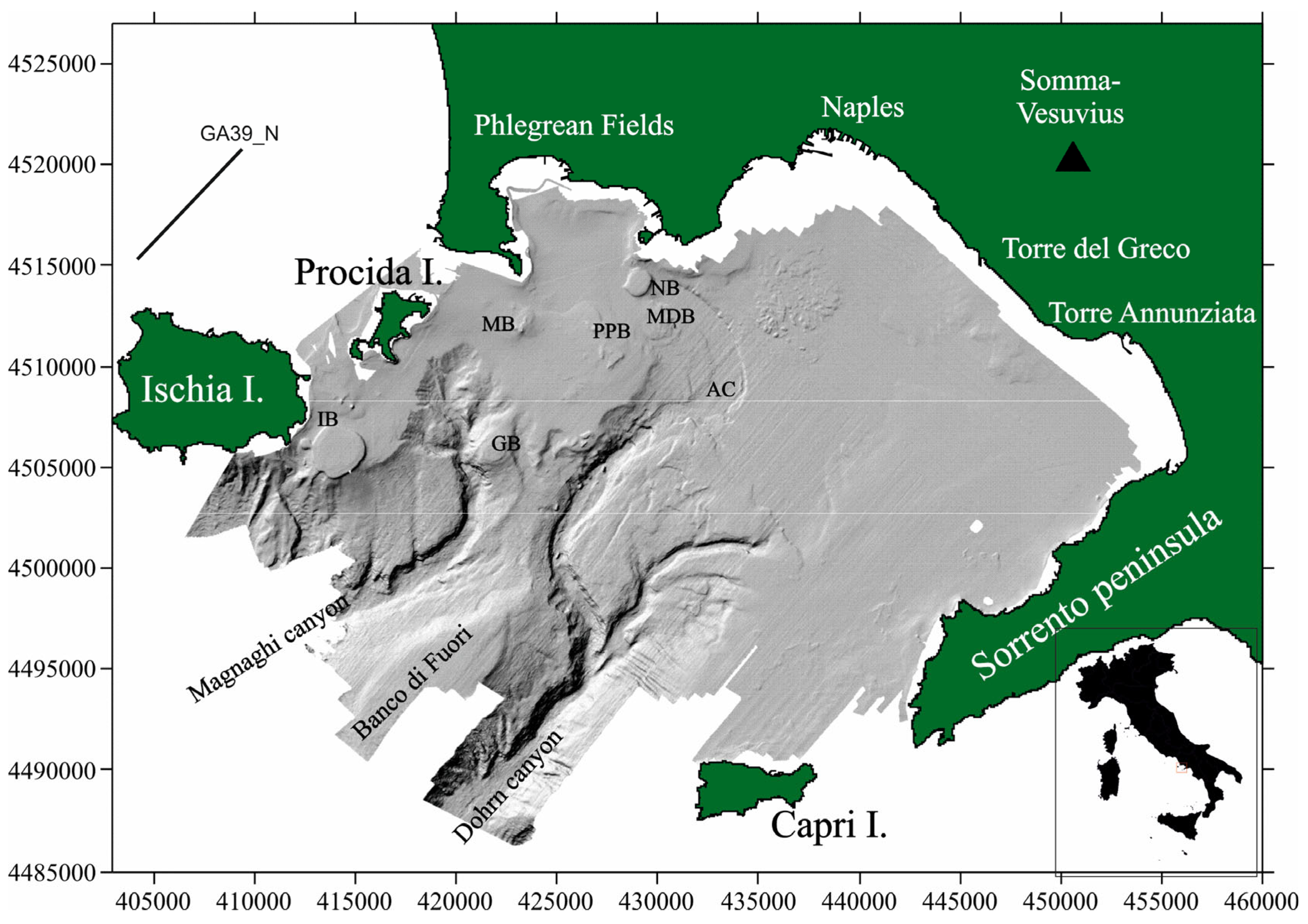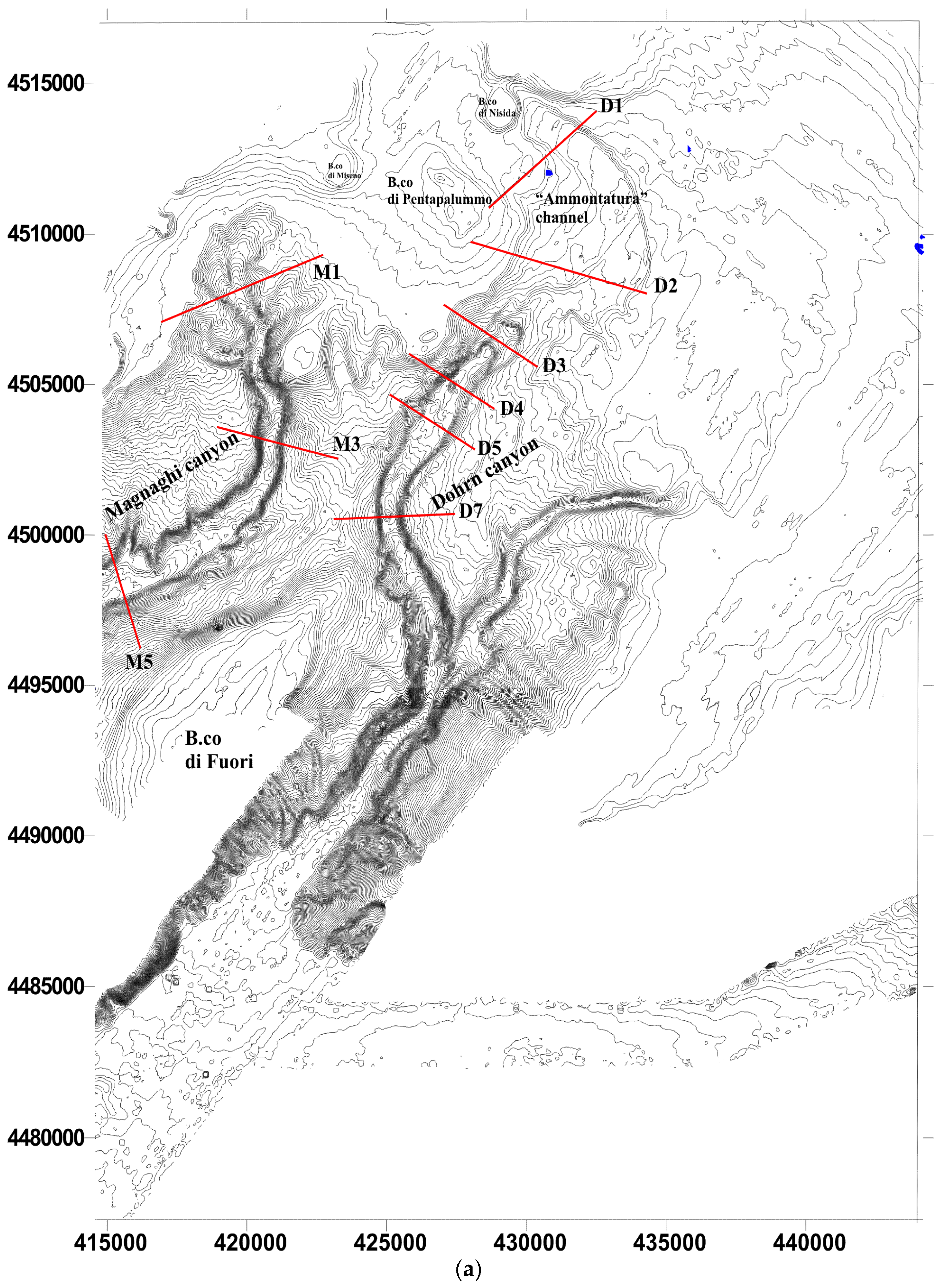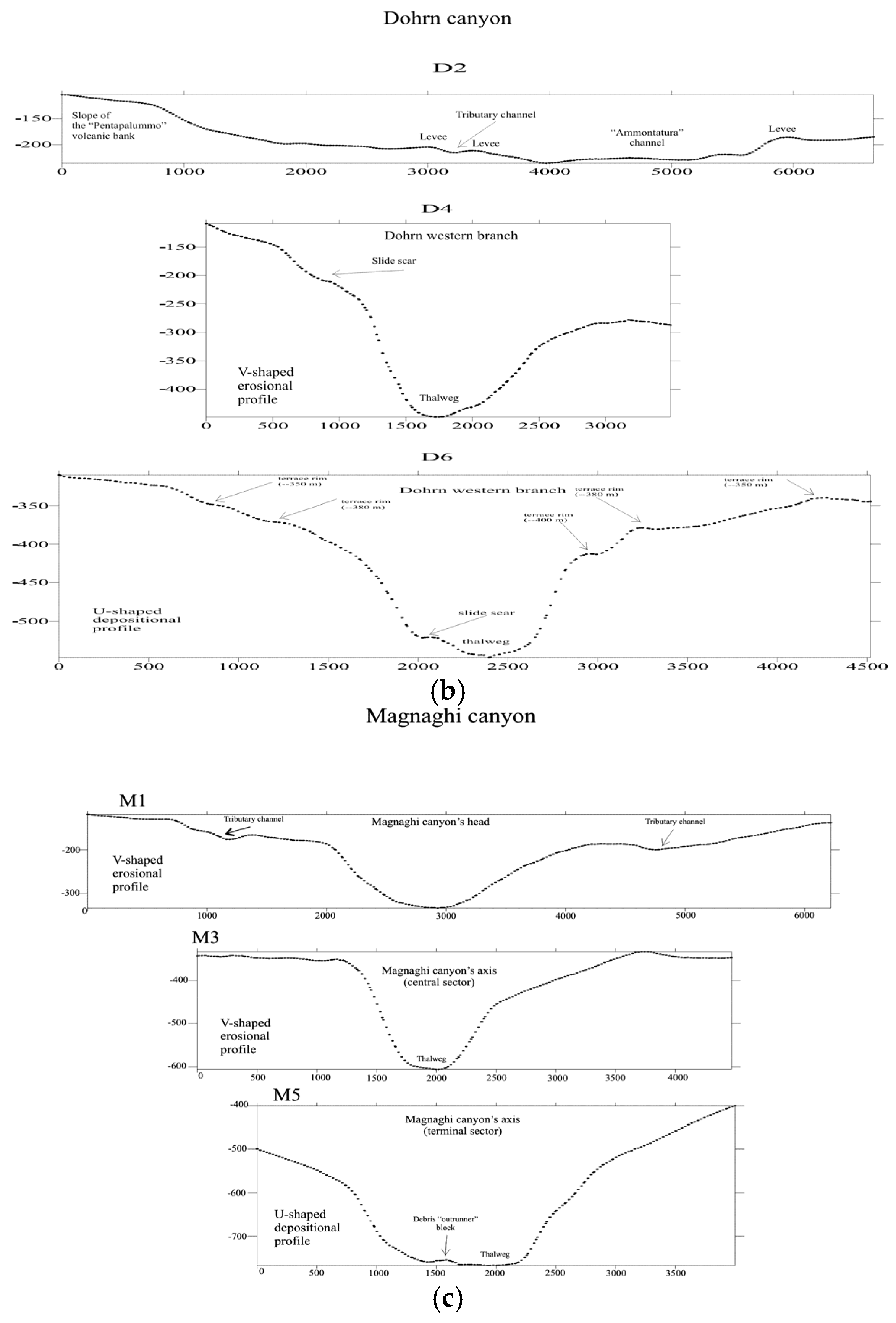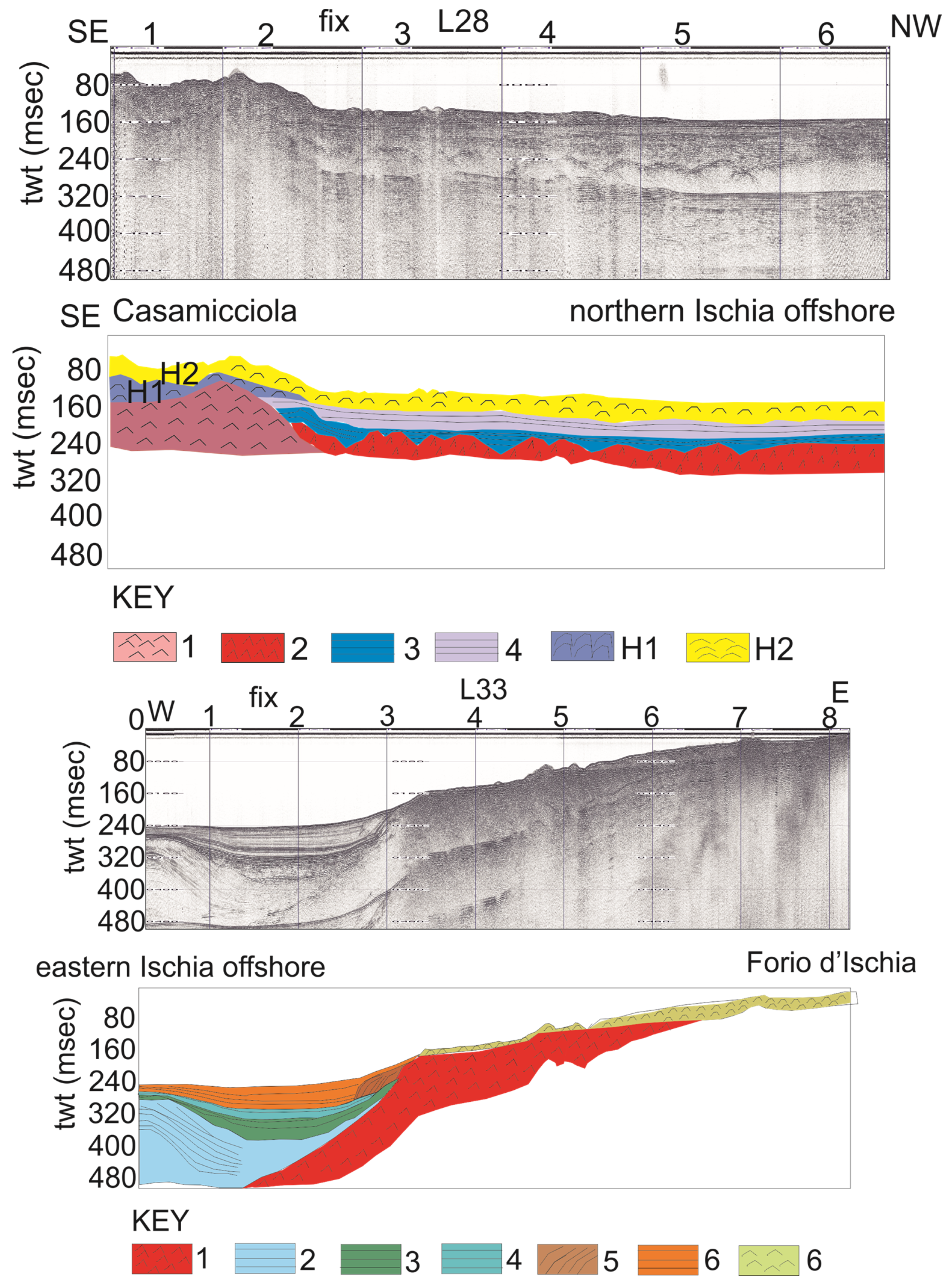Submarine Instability Processes on the Continental Slope Offshore of Campania (Southern Italy)
Abstract
1. Introduction
- -
- Geological analysis of the instability phenomena in the Campania submarine slopes at several scales. In particular, the slow submarine instabilities (creeping, slumping, deep-seated gravitational deformation) are distinguished from the fast submarine instabilities (debris avalanches, rock falls, roto-translational slides) offshore of Campania with marine geological methods (morpho-bathymetry, high-resolution seismic profiles, Sidescan Sonar sonograms, sea bottom samples).
- -
- A chrono-stratigraphic framework of the events of submarine instability and their correlation with the trigger geological processes, including seismicity, volcanism and tectonic activity.
- -
- Implementation of technology and database for acquiring and processing morpho-bathymetric, seismo-stratigraphic, and sedimentological data in the submarine slopes characterized by gravitational instability.
- -
- Analysis of the geological factors triggering the submarine instabilities in the slope areas, including the following: increase in steepness of the topographic profile of the slope following high sedimentary supply and consequent exceeding of the critical stability angle of the submarine slope; increase in water content on sediment slopes and triggering of slumping and creeping phenomena on high and medium slope slopes. Other trigger factors are represented by the emersion/erosion phenomena and subsequent flooding in correspondence with glacio-eustatic oscillations of the sea level during the Upper Quaternary, by the presence of discontinuity surfaces within the stratigraphic record that represents potential sliding planes, by the presence of gas hydrate pockets within the stratigraphic succession [15], and finally, by the tectonic activity in correspondence with regional direct or strike–slip faults [16]. The strata density reversal represents another possible cause. When a dense layer lies on top of a weaker layer, then the collapse should occur. Biscontin and Pestana [17] have discussed the importance of several factors controlling the response of submarine slopes during seismic loading. A dynamic finite element code has been used, including a law based on the anisotropic stress–strain–strength behavior of normally consolidated to lightly over-consolidated clays. Parametric site response analyses on slope geometry and layering, soil material parameters, and input ground motion characteristics have been shown [17]. During a seismic event, the slope performance is controlled by several factors, including the predicted maximum shear strains, the permanent deformations, the displacement time histories and the maximum excess pore pressure.
2. Materials and Methods
3. Results
3.1. Gravitational Instability on the Naples Slope and Ischia Island
3.2. Theoretical Models of Slope Stability and Slope Analysis of the Naples Bay
3.3. The Influence of Shallow Gas on Gravitational Instabilities: The Volturno Offshore
4. Discussion
5. Conclusions
Funding
Data Availability Statement
Conflicts of Interest
References
- Aiello, G.; Marsella, E.; Passaro, S. Submarine instability processes on the continental slopes off the Campania region (southern Tyrrhenian Sea, Italy): The case history of Ischia Island (Naples Bay). Boll. Geofis. Teor. Appl. 2009, 50, 193–207. [Google Scholar]
- Milia, A.; Torrente, M.M.; Giordano, F. Chapter 4 Gravitational instability of submarine volcanoes offshore Campi Flegrei (Naples Bay, Italy). In Developments in Volcanology, 1st ed.; De Vivo, B., Ed.; Elsevier: Amsterdam, The Netherlands, 2006; Volume 9, pp. 69–83. [Google Scholar] [CrossRef]
- Rosi, M.; Sbrana, A. Phlegrean Fields; CNR, National Research Council of Italy, Scientific Monograph: Rome, Italy, 1987. [Google Scholar]
- Steinmann, L.; Spiess, V.; Sacchi, M. The Campi Flegrei caldera (Italy): Formation and evolution in interplay with sea-level variations since the Campanian Ignimbrite eruption at 39ka. J. Volcanol. Geotherm. Res. 2016, 327, 361–374. [Google Scholar] [CrossRef]
- Sbrana, A.; Marianelli, P.; Pasquini, G. The Phlegrean Fields volcanological evolution. J. Maps 2021, 17, 557–570. [Google Scholar] [CrossRef]
- Aiello, G.; Iorio, M.; Molisso, F.; Sacchi, M. Integrated Morpho-Bathymetric, Seismic-Stratigraphic, and Sedimentological Data on the Dohrn Canyon (Naples Bay, Southern Tyrrhenian Sea): Relationships with Volcanism and Tectonics. Geosciences 2020, 10, 319. [Google Scholar] [CrossRef]
- Aiello, G.; Caccavale, M. The Coastal Areas of the Bay of Naples: The Sedimentary Dynamics and Geological Evolution of the Naples Canyons. Geosciences 2023, 13, 226. [Google Scholar] [CrossRef]
- Di Fiore, V.; Aiello, G.; D’Argenio, B. Gravity instabilities in the Dohrn Canyon (Bay of Naples, Southern Tyrrhenian Sea): Potential wave and run-up (tsunami) reconstruction from a fossil submarine landslide. Geol. Carpathica 2011, 62, 55–63. [Google Scholar] [CrossRef]
- Foglini, F.; Rovere, M.; Tonielli, R.; Castellan, G.; Prampolini, M.; Budillon, F.; Cuffaro, M.; Di Martino, G.; Grande, V.; Innangi, S.; et al. A new multi-grid bathymetric dataset of the Gulf of Naples (Italy) from complementary multi-beam echo sounders. Earth Syst. Sci. Data 2025, 17, 181–203. [Google Scholar] [CrossRef]
- Aiello, G. Regional Geological Data of the Volturno basin filling and relationships with the Massico structure. J. Mar. Sci. Eng. 2025, 13, 241. [Google Scholar] [CrossRef]
- Varnes, D.J. Landslide types and processes. In Landslides and Engineering Practice, Special Report 28. Highway Research Board; Eckel, E.B., Ed.; National Academy of Sciences: Washington, DC, USA, 1954; pp. 20–47. [Google Scholar]
- Hungr, O.; Leroueil, S.; Picarelli, L. The Varnes classification of landslide types, an update. Landslides 2013, 11, 167–194. [Google Scholar] [CrossRef]
- Terzaghi, K.; Peck, R. Soil Mechanics in Engineering Practice, 2nd ed.; John Wiley & Sons: Hoboken, NJ, USA, 1996. [Google Scholar]
- Edil, T.B.; Vallejo, L.E. Mechanics of coastal landslides and the influence of slope parameters. Eng. Geol. 1980, 16, 83–96. [Google Scholar] [CrossRef]
- Aiello, G.; Caccavale, M. New Seismoacoustic Data on Shallow Gas in Holocene Marine Shelf Sediments, Offshore from the Cilento Promontory (Southern Tyrrhenian Sea, Italy). J. Mar. Sci. Eng. 2022, 10, 1992. [Google Scholar] [CrossRef]
- Aiello, G.; Marsella, E.; Di Fiore, V.; D’Isanto, C. Stratigraphic and structural styles of half-graben offshore basins: Multichannel seismic and Multibeam morpho-bathymetric evidences on the Salerno Valley (Southern Campania continental margin, Italy). Quad. Geofis. 2009, 77, 1–34. [Google Scholar]
- Biscontin, G.; Pestana, J.M. Factors affecting seismic response of submarine slopes. Nat. Hazards Earth Syst. Sci. 2006, 6, 97–107. [Google Scholar] [CrossRef]
- Cukur, D.; Kim, S.P.; Kong, G.S.; Bahk, J.; Horozal, S.; Um, I.; Lee, G.; Chang, T.; Ha, H.; Volker, D.; et al. Geophysical evidence and inferred triggering factors of submarine landslides on the western continental margin of the Ulleung Basin, East Sea. Geo-Mar. Lett. 2016, 36, 425–444. [Google Scholar] [CrossRef]
- Jing, S. Triggers, Mechanisms and Frequency of Slope Instability Processes on Mid-Norway’s Continental Margin. Ph.D. Thesis, Cardiff University, Cardiff, UK, June 2023. [Google Scholar]
- Chiocci, F.L.; Cattaneo, A.; Urgeles, R. Seafloor mapping for geohazard assessment: State of the art. Mar. Geophys. Res. 2011, 32, 1–11. [Google Scholar] [CrossRef]
- Budillon, F.; Martorelli, E.; Conforti, A.; De Falco, G.; Bosman, A.; Di Martino, G.; Firetto Carlino, M.; Innangi, S.; Pierdomenico, M.; Sposato, A.; et al. Geohazard features of the Gulf of Naples and Pontine Islands (Eastern Tyrrhenian Sea). J. Maps 2024, 20. [Google Scholar] [CrossRef]
- Mitchum, R.M.; Vail, P.R.; Thompson, S. Seismic stratigraphy and global changes of sea-level, part 2: The depositional sequence as a basic unit for stratigraphic analysis. In Seismic Stratigraphy—Applications to Hydrocarbon Exploration; Memoir 26; Payton, C.E., Ed.; American Association of Petroleum Geologists: Tulsa, OK, USA, 1977; pp. 53–62. [Google Scholar]
- Vail, P.R.; Mitchum, R.M.; Thompson, S. Seismic stratigraphy and global changes of sea level, part IV: Global cycles of relative changes of sea level. In Seismic Stratigraphy—Applications to Hydrocarbon Exploration; Memoir 26; Payton, C.E., Ed.; American Association of Petroleum Geologists: Tulsa, OK, USA, 1977; pp. 83–98. [Google Scholar]
- Catuneanu, O.; Abreu, V.; Bhattacharya, J.P.; Blum, M.D.; Dalrymple, R.W.; Eriksson, P.G.; Fielding, C.R.; Fisher, W.L.; Galloway, W.E.; Gibling, M.R.; et al. Towards the standardization of sequence stratigraphy. Earth-Sci. Rev. 2009, 92, 1–33. [Google Scholar] [CrossRef]
- Aiello, G.; Budillon, F.; Cristofalo, G.; D’Argenio, B.; de Alteriis, G.; De Lauro, M.; Ferraro, L.; Marsella, E.; Pelosi, N.; Sacchi, M.; et al. Marine Geology and Morphobathymetry in the Bay of Naples (South-Eastern Tyrrhenian Sea, Italy). In Mediterranean Ecosystems; Faranda, F.M., Guglielmo, L., Spezie, G., Eds.; Springer: Milano, Italy, 2001. [Google Scholar] [CrossRef]
- D’Argenio, B.; Aiello, G.; de Alteriis, G.; Milia, A.; Sacchi, M. Digital Elevation Model of the Naples Bay and Adjacent Areas, Eastern Tyrrhenian Sea. In Mapping Geology in Italy; Pasquarè, E., Venturini, G., Eds.; Atlante di Cartografia Geologica: Firenze, Italy, 2004; pp. 21–28. [Google Scholar]
- Somma, R.; Iuliano, S.; Matano, F.; Molisso, F.; Passaro, S.; Sacchi, M.; De Natale, G. High-resolution morpho-bathymetry of Pozzuoli Bay, southern Italy. J. Maps 2015, 12, 222–230. [Google Scholar] [CrossRef]
- Passaro, S.; Tamburrino, S.; Vallefuoco, M.; Gherardi, S.; Sacchi, M.; Ventura, G. High-resolution morpho-bathymetry of the Gulf of Naples, Eastern Tyrrhenian Sea. J. Maps 2016, 12, 203–210. [Google Scholar] [CrossRef]
- Iorio, M.; Meo, A.; Aiello, G.; Senatore, M.R. The Neapolitan Yellow Tuff record in the Gaeta Gulf (Eastern Tyrrhenian margin, Southern Italy). Adv. Geosci. 2024, 63, 15–27. [Google Scholar] [CrossRef]
- Gianardi, R.; Bisson, M.; Cocchi, L.; Isaia, R.; Passaro, S.; Sepe, V.; Spinetti, C. From land to sea: A new high-resolution bathymetry and topography of the Campi Flegrei area, Southern Italy. J. Maps 2024, 20, 2404873. [Google Scholar] [CrossRef]
- Aiello, G.; Sacchi, M. New morpho-bathymetric data on marine hazard in the offshore of Gulf of Naples (Southern Italy). Nat. Hazards 2022, 111, 2881–2908. [Google Scholar] [CrossRef]
- Della Seta, M.; Marotta, E.; Orsi, G.; De Vita, S.; Sansivero, F.; Fredi, P. Slope instability induced by volcano-tectonics as an additional source of hazard in active volcanic areas: The case of Ischia island (Italy). Bull. Volcanol. 2012, 74, 79–106. [Google Scholar] [CrossRef]
- Chiocci, F.L.; de Alteriis, G. The Ischia debris avalanche: First clear submarine evidence in the Mediterranean of a volcanic island prehistorical collapse. Terra Nova 2006, 18, 202–209. [Google Scholar] [CrossRef]
- De Alteriis, G.; Insinga, D.D.; Morabito, S.; Morra, V.; Chiocci, F.L.; Terrasi, F.C.; Lubritto, C.C.; Di Benedetto, C.; Pazzanese, M. Age of submarine debris avalanches and tephrostratigraphy offshore Ischia Island, Tyrrhenian Sea, Italy. Mar. Geol. 2010, 278, 1–18. [Google Scholar] [CrossRef]
- Aiello, G.; Marsella, E.; Passaro, S. Stratigraphic and structural setting of the Ischia volcanic complex (Naples Bay, Southern Italy) revealed by submarine seismic reflection data. Rend. Fis. Acc. Lincei 2012, 23, 387–408. [Google Scholar] [CrossRef]
- Aiello, G.; Caccavale, M. Quaternary Evolution of Ischia: A Review of Volcanology and Geology. Appl. Sci. 2023, 13, 3554. [Google Scholar] [CrossRef]
- Milia, A.; Aiello, G.; Iannace, P.; Torrente, M.M. Complex stratigraphic relationships between volcanic features and sedimentary deposits in a submarine environment: The northern offshore Holocene Ischia volcanic field (Italy). J. Volcanol. Geotherm. Res. 2021, 419, 107379. [Google Scholar] [CrossRef]
- Ruggieri, S.; Aiello, G.; Marsella, E. Integrated marine geophysical data interpretation of the Naples Bay continental slope (southern Tyrrhenian Sea, Italy). Boll. Di Geofiisica Teor. Appl. 2007, 48, 1–24. [Google Scholar]
- Fusi, N.; Mirabile, L.; Camerlenghi, A.; Ranieri, G. Marine geophysical survey of the Gulf of Naples (Italy): Relationships between submarine volcanic activity and sedimentation. Mem. Soc. Geol. It. 1991, 47, 95–114. [Google Scholar]
- Pratson, L.F.; Coakley, B.J. A model for the headward erosion of submarine canyons induced by downslope eroding sedimentary flows. Geol. Soc. Am. Bull. 1986, 108, 225–234. [Google Scholar] [CrossRef]
- Cronin, B.T.; Akhmetzhanov, A.M.; Mazzini, A.; Akhmanov, G.; Ivanov, M.; Kenyon, N.H. Morphology, evolution and fill: Implications for sand and mud distribution in filling deep-water canyons and slope channel complexes. Sediment. Geol. 2005, 179, 71–97. [Google Scholar] [CrossRef]
- Harris, P.T.; Whiteway, T. Global distribution of large submarine canyons: Geomorphic differences between active and passive continental margins. Mar. Geol. 2011, 285, 69–86. [Google Scholar] [CrossRef]
- Sultan, N.; Cochonat, P.; Canals, M.; Cattaneo, A.; Dennielou, B.; Haflidason, H.; Laberg, J.S.; Long, D.; Mienert, J.; Trincardi, F.; et al. Triggering mechanisms of slope instability processes and sediment failures on continental margins: A geotechnical approach. Mar. Geol. 2004, 213, 291–321. [Google Scholar] [CrossRef]
- Daigle, H.; Cook, A.; Fang, Y.; Bihani, A.; Song, W.; Flemings, P.B. Gas-driven tensile fracturing in shallow marine sediments. J. Geophys. Res. Solid Earth 2020, 125, e2020JB020835. [Google Scholar] [CrossRef]
- Karstens, J.; Jonas Preine, J.; Carey, S.; Katherine, L.C.; Bell, K.L.C.; Nomikou, P.; Hübscher, C.; Lampridou, D.; Urlaub, M. Formation of undulating seafloor bedforms during the Minoan eruption and their implications for eruption dynamics and slope stability at Santorini. Earth Planet. Sci. Lett. 2023, 616, 118215. [Google Scholar] [CrossRef]
- Jin, J.; Hu, J.; Li, L.; Li, J.; Zhu, Z.; Wang, X.; Zhou, J.; Wang, W. Submarine Slides and Their Influence on Gas Hydrate and Shallow Gas in the Pearl River Mouth Basin. J. Mar. Sci. Eng. 2025, 13, 308. [Google Scholar] [CrossRef]
- Zhang, C.; Hou, J. Creep characteristics of muddy submarine channel slope instability. Front. Mar. Sci 2022, 9, 999151. [Google Scholar] [CrossRef]
- Del Pezzo, E.; Bianco, F. Space and time distribution of seismic source energy at Campi Flegrei, Italy through the last unrest phase (1.1.2000–31.12.2023). Phys. Earth Planet. Inter. 2024, 356, 107258. [Google Scholar] [CrossRef]
- De Alteriis, G.; Violante, C. Catastrophic landslides off Ischia volcanic island (Italy) during prehistory. Geol. Soc. Lond. Spec. Publ. 2009, 322, 73–104. [Google Scholar] [CrossRef]
- de Vita, S.; Fabio Sansivero, F.; Giovanni Orsi, G.; Enrica Marotta, E. Cyclical slope instability and volcanism related to volcano-tectonism in resurgent calderas: The Ischia island (Italy) case study. Eng. Geol. 2006, 86, 148–165. [Google Scholar] [CrossRef]
- Brown, R.; Orsi, G.; de Vita, S. New insights into Late Pleistocene explosive volcanic activity and caldera formation on Ischia (southern Italy). Bull. Volcanol. 2008, 70, 583–603. [Google Scholar] [CrossRef]
- Vineberg, S.O.; Isaia, R.; Albert, P.G.; Brown, R.G.; Smith, V.C. Insights into the explosive eruption history of the Campanian volcanoes prior to the Campanian Ignimbrite eruption. J. Volcanol. Geotherm. Res. 2023, 443, 107915. [Google Scholar] [CrossRef]
- Aiello, G.; Marsella, E. The Southern Ischia Canyon System: Examples of Deep Sea Depositional Systems on the Continental Slope off Campania. Rend. Online Della Soc. Geol. Ital. 2014, 32, 28–37. [Google Scholar] [CrossRef]














| Gravitational Instability | Onshore | Inferred Age | Offshore | Seismic Facies | Volcano-Tectonic Event |
|---|---|---|---|---|---|
| Debris avalanche (DA) | Lacco Ameno DA (onshore) | >6.0 ka B.P.; upper age boundary is given by the overlying beach deposits (Mezzavia sequence); Holocene s.l. (based on De Alteriis and Violante, 2009) [49] | Seismo-stratigraphic unit of the Lacco Ameno DA (offshore) | Wedge-shaped Acoustically transparent | Triggered by a volcano-tectonic event, based on the similarity with other historical debris avalanches documented in this area |
| Debris avalanche | Pietre Rosse DA (onshore) | Overlying the Citara Formation (40 ky B.P.); Holocene s.l. based on De Alteriis and Violante, 2009 [49] | Seismo-stratigraphic unit of the Forio DA (Punta del Soccorso; Figure 5) | Chaotic to discontinuous seismic reflectors | Triggered by a volcano-tectonic event, based on the similarity with other historical debris avalanches documented in this area |
| Debris avalanche | Casamicciola DA (onshore) | ≤Eight century B.C. The lower age boundary is given by the underlying deposits of the Punta La Scrofa tephra based on De Vita et al., 2006 [50] | Seismo-stratigraphic unit of the Casamicciola DA (Casamicciola offshore; based on Aiello et al., 2009 [1] | Chaotic to discontinuous seismic reflectors | Triggered by a volcano-tectonic event, based on the similarity with other historical debris avalanches documented in this area |
| Debris avalanche | Ischia DA (onshore). Slide scar involving the whole southern flank of the island. | Historical (based on the core data shown by De Alteriis et al. (2010) [34] | Seismo-stratigraphic unit of the IDA (De Alteriis et al.) [34] | Hummocky Occurrence of giant blocks, whose dimensions decrease, proceeding southwards | Volcano-tectonic scar of the southern flank of the island |
Disclaimer/Publisher’s Note: The statements, opinions and data contained in all publications are solely those of the individual author(s) and contributor(s) and not of MDPI and/or the editor(s). MDPI and/or the editor(s) disclaim responsibility for any injury to people or property resulting from any ideas, methods, instructions or products referred to in the content. |
© 2025 by the author. Licensee MDPI, Basel, Switzerland. This article is an open access article distributed under the terms and conditions of the Creative Commons Attribution (CC BY) license (https://creativecommons.org/licenses/by/4.0/).
Share and Cite
Aiello, G. Submarine Instability Processes on the Continental Slope Offshore of Campania (Southern Italy). GeoHazards 2025, 6, 20. https://doi.org/10.3390/geohazards6020020
Aiello G. Submarine Instability Processes on the Continental Slope Offshore of Campania (Southern Italy). GeoHazards. 2025; 6(2):20. https://doi.org/10.3390/geohazards6020020
Chicago/Turabian StyleAiello, Gemma. 2025. "Submarine Instability Processes on the Continental Slope Offshore of Campania (Southern Italy)" GeoHazards 6, no. 2: 20. https://doi.org/10.3390/geohazards6020020
APA StyleAiello, G. (2025). Submarine Instability Processes on the Continental Slope Offshore of Campania (Southern Italy). GeoHazards, 6(2), 20. https://doi.org/10.3390/geohazards6020020






